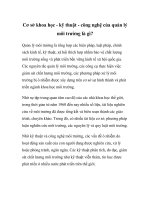Quản lý tồn kho là gì
Bạn đang xem bản rút gọn của tài liệu. Xem và tải ngay bản đầy đủ của tài liệu tại đây (26.56 MB, 32 trang )
GLOBAL LOGISTIC MANAGEMENT
GLOBAL LOGISTIC MANAGEMENT
LECTURE 3: INVENTORY
MANAGEMENT
Agenda
Agenda
1 What is Inventory Management
2 Two forms of Demand
3 Inventory and Supply Chain
Management
4 Inventory and Quality Management
5 Inventory Control system
6 Economic Order Quantity (EOQ)
Models
Agenda
Agenda
7 Production Quantity Model
8 Quantity Discounts
9 Reorder Point
10 Safety Stocks
1 What is Inventory management
1 What is Inventory management
?
?
Inventory management is the process
of trading off the level of inventory
held to achieve high customer service
levels with the cost of holding
inventory, including capital tied up in
inventory, variable storage costs and
obsolescence.
The purpose of Inventory
Management:
◦
how many units to order
◦
when to order
2 Two forms of Demand
2 Two forms of Demand
Dependent
Dependent
◦
Demand for items used to produce final
Demand for items used to produce final
products
products
◦
Tires stored at a Goodyear plant are an
example of a dependent demand item
Independent
Independent
◦
Demand for items used by external
Demand for items used by external
customers
customers
◦
Cars, appliances, computers, and
houses are examples of independent
demand inventory
3 Inventory and Supply Chain
3 Inventory and Supply Chain
Management
Management
Bullwhip effect
◦
demand information is distorted as it
moves away from the end-use
customer
◦
higher safety stock inventories to are
stored to compensate
Seasonal or cyclical demand
Inventory provides independence from
vendors
Take advantage of price discounts
Inventory provides independence
between stages and avoids work stop-
pages
4 Inventory and Quality
4 Inventory and Quality
Management
Management
Customers usually perceive quality
service as availability of goods they
want when they want them
Inventory must be sufficient to provide
high-quality customer service in Total
Quality Management (TQM)
5 Inventory Control System
5 Inventory Control System
Continuous system (fixed-order-
Continuous system (fixed-order-
quantity)
quantity)
◦
constant amount ordered when
constant amount ordered when
inventory declines to
inventory declines to
predetermined level
predetermined level
Periodic system (fixed-time-period)
Periodic system (fixed-time-period)
◦
order placed for variable amount
order placed for variable amount
after fixed passage of time
after fixed passage of time
6 Economic Order Quantity
6 Economic Order Quantity
(EOQ) Models
(EOQ) Models
EOQ
◦
optimal order quantity that will minimize total
inventory costs
Basic EOQ model
Production quantity model
Assumptions of EOQ Model:
Demand is known with certainty and is
Demand is known with certainty and is
constant over time
constant over time
No shortages are allowed
No shortages are allowed
Lead time for the receipt of orders is
Lead time for the receipt of orders is
constant
constant
Order quantity is received all at once
Order quantity is received all at once
Order Inventory Cycle
Order Inventory Cycle
Demand
Demand
rate
rate
Time
Time
Lead
Lead
time
time
Lead
Lead
time
time
Order
Order
placed
placed
Order
Order
placed
placed
Order
Order
receipt
receipt
Order
Order
receipt
receipt
Inventory Level
Inventory Level
Reorder point,
Reorder point,
R
R
Order quantity,
Order quantity,
Q
Q
0
0
EOQ Cost Model
EOQ Cost Model
C
C
o
o
- cost of placing order
- cost of placing order
D
D
- annual demand
- annual demand
C
C
c
c
- annual per-unit carrying cost
- annual per-unit carrying cost
Q
Q
- order quantity
- order quantity
Annual ordering cost =
Annual ordering cost =
C
C
o
o
D
D
Q
Q
Annual carrying cost =
Annual carrying cost =
C
C
c
c
Q
Q
2
2
Total cost = +
Total cost = +
C
C
o
o
D
D
Q
Q
C
C
c
c
Q
Q
2
2
EOQ Cost model
EOQ Cost model
TC = +
C
o
D
Q
C
c
Q
2
= +
C
o
D
Q
2
C
c
2
∂ TC
∂ Q
0 = +
C
0
D
Q
2
C
c
2
Q
opt
=
2C
o
D
C
c
Deriving Q
opt
Proving equality of
costs at optimal point
=
C
o
D
Q
C
c
Q
2
Q
2
=
2C
o
D
C
c
Q
opt
=
2C
o
D
C
c









